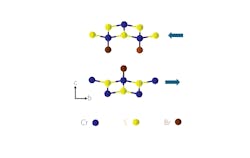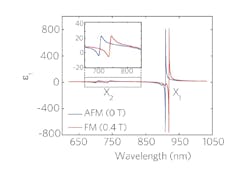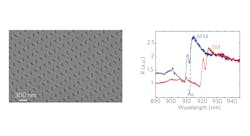Magnetic quantum materials meet photonics: Bridging predictability and surprise
Light is the fastest and cleanest carrier of information we know. The science and technology of guiding, manipulating, and detecting light—photonics—underpins every facet of modern life, from the global internet and medical imaging to precision manufacturing and autonomous sensing.
For decades, the photonics industry has flourished in an environment of predictability. Much of linear optics is mapped out; Maxwell’s equations provide an exact playbook that allows engineers to predict the performance of a device with near-certainty. This certainty is enabled by mature, reliable materials like silicon, silica, and silicon nitride, which are incredibly well-characterized. As a result, photonics has become an engineer’s field as much as a physicist’s: You can design, simulate, fabricate, and almost always get exactly the expected result.
In stark contrast lies the world of quantum materials. These are solids where the collective, cooperative behavior of electrons gives rise to entirely new states of matter. They promise breakthroughs in computing, energy, and sensing because their properties can go far beyond the static limitations of ordinary materials. This field is characterized by fundamental complexity and surprise. Even qualitatively, the many-body interactions are so intertwined that there is no simple equivalent to Maxwell's equations to neatly guide us. Spin, charge, valley, and lattice degrees of freedom are all coupled, meaning every knob a researcher turns pulls on several others at once. It remains very much a physicist’s playground, where experiments frequently reveal unexpected phenomena that theory struggles to catch up with.
This intellectual and technological orthogonality—the certainty of photonics meeting the surprise of quantum matter—is profoundly interesting. It presents an opportunity to inject the rich, dynamic tunability of emergent phenomena into the stable platform of integrated optics. This is the fertile middle ground where our work resides.
A new spin on light: Magnetic control in CrSBr
Our recent efforts have focused on an unusual two-dimensional (2D) magnet: CrSBr, a van der Waals antiferromagnetic semiconductor. This material has a layered structure with strong in-plane bonds, but very weak out-of-plane interactions. In its most stable, low-temperature state (below 132 K), the spins on the chromium atoms within each layer align together, but adjacent layers feature spins that point in opposite directions (see Fig. 1).1
The truly extraordinary feature here is the material’s active response to external control. By applying a magnetic field, we can continuously tune the relative orientation of the spins in adjacent layers from a fully compensated (antiferromagnetic) to a fully spin-polarized (ferromagnetic) state. This magnetic state transition drastically modifies the material’s optical properties. Specifically, strong light-matter excitations, known as “excitons,” have a resonance energy that varies significantly with the magnetic order. Since the refractive index determines nearly all linear optical behavior, this variation means that the index itself is strongly and dynamically modified by the magnetic field (see Fig. 2).
The magnitude of this effect is unprecedented in integrated optics. The real part of the permittivity, a value directly related to the refractive index, can reach up to 800 near the excitonic resonance. To put this into perspective against conventional materials, the permittivity of silicon is about 13, and silicon nitride is about 4 within the visible and near-infrared. This giant optical response enables extreme miniaturization for functional photonic devices.
Furthermore, this material offers continuous refractive index switching, setting it apart from materials that only offer binary states. Conventional active materials, like phase-change glasses or vanadium dioxide, typically only switch between two discrete optical states (crystalline and amorphous, or metal to insulator). The uniqueness of CrSBr lies in its analogue tunability across a wide spectral range. This continuous control is a direct, technological dividend resulting from the intertwined degrees of freedom—magnetic and optical—within this quantum material.
Tuning light magnetically within devices
We have already translated these properties into functional nanophotonic devices.2 By fabricating thin films of CrSBr into patterned photonic crystal slabs, we created monolithic structures where light is entirely confined within the quantum material. The structures exhibit guided-mode resonances with experimentally measured quality factors above 1,200, despite film thicknesses of only ~2% of the optical wavelength. Importantly, these high Q-factors stem from the material's anomalously large refractive index, not from engineering the photonic mode to yield a large Q-factor, for example, by enforcing the symmetry of the mode to decouple from the radiation continuum.
The true breakthrough is the magneto-optic control. A magnetic-field-induced transition rigidly redshifts the photonic resonances by as much as 10 nm at around 910 nm, and up to 30 nm at around 710 nm due to a plethora of magneto-excitonic resonances, which allows us to achieve on-demand switching of optical modes (see Fig. 3). By applying the magnetic field along a perpendicular direction, we can also tune the spectral position of the resonances continuously. Although the excitonic resonances shift only by 10 to 30 nm, the resulting permittivity contrast between the antiferromagnetic (AFM) and ferromagnetic (FM) states is larger than the static silicon nitride-to-air contrast across a spectral window of almost 200 nm within the visible and infrared.
CrSBr presents an exciting new direction for integrated circuits. Its advantages are compelling: It is continuously tunable and provides massive spectral shifts. The magnetic tunability introduces a new degree of freedom for device design, which enables compact and reconfigurable photonic components driven by magnetic fields. Beyond magnetic fields, the strong spin-exciton coupling suggests that all-optical (perhaps ultrafast) tunability or even mechanical strain could serve as alternative control knobs. Finally, CrSBr is part of the larger material family, implying that chemical substitution and doping could be used to shift the operating wavelength and tuning range away from the current 900-nm exciton and potentially increase the critical temperature.
But challenges remain. The most significant obstacle for widespread applications is the current requirement for cryogenic temperatures, because the magnetic order sets in below 132 K. The necessary magnetic fields, while small for a lab setting, are relatively large for chipscale integration. Complementary metal-oxide semiconductor (CMOS) compatibility is not yet clear; while chipscale transfer techniques for van der Waals materials are advancing rapidly, large-scale uniform growth of CrSBr is likely challenging.
In summary, CrSBr offers a striking demonstration of how quantum order can reshape optical response. While cryogenic temperatures and moderate magnetic fields currently constrain its practicality, its enormous refractive index tunability shows that complex magnetic materials can offer entirely new regimes of optical control. As synthesis and integration methods mature, materials like CrSBr may help redefine what is achievable in actively controlled photonics.
REFERENCES
1. See https://doi.org/10.17188/1199151.
2. A. K. Demir et al., Nat. Photon., 19, 1006–1012 (2025); https://doi.org/10.1038/s41566-025-01712-2.
About the Author
Ahmet Kemal Demir
Ahmet Kemal Demir is a graduate student in the Department of Physics at Massachusetts Institute of Technology (MIT; Cambridge, MA).
Luca Nessi
Luca Nessi is a postdoctoral associate in the Department of Physics at Politecnico di Milano (Italy).
Sachin Vaidya
Sachin Vaidya is a postdoctoral associate in the Department of Physics at Massachusetts Institute of Technology (MIT; Cambridge, MA).
Connor A. Occhialini
Connor A. Occhialini is a postdoctoral associate in the Department of Physics at Columbia University (New York, NY).
Marin Soljačić
Marin Soljačić is the Cecil and Ida Green Professor of Physics at Massachusetts Institute of Technology (MIT; Cambridge, MA).
Riccardo Comin
Riccardo Comin is Massachusetts Institute of Technology (MIT)’s Class of 1947 Career Development Associate Professor of Physics.


